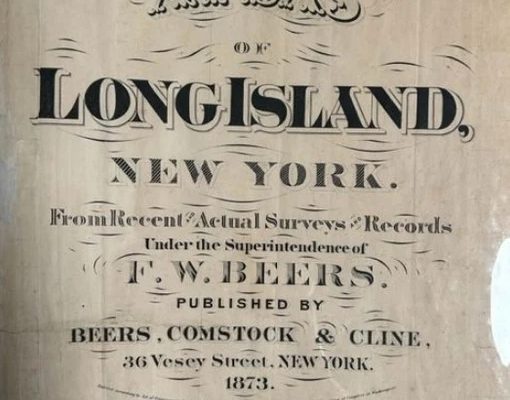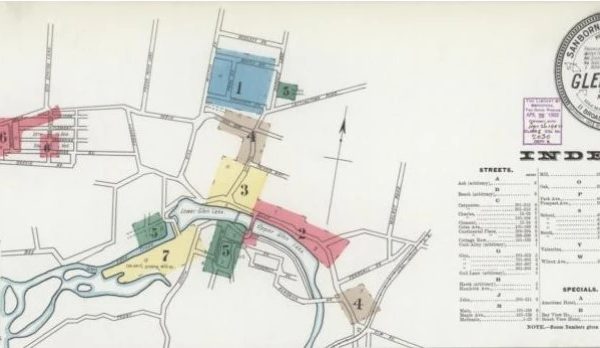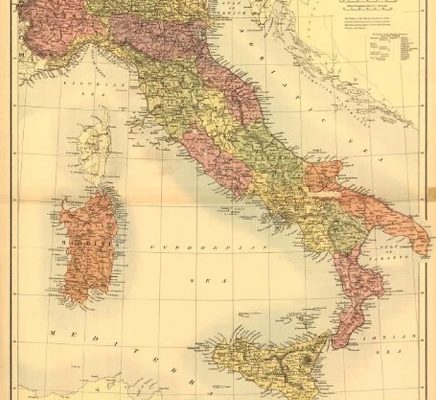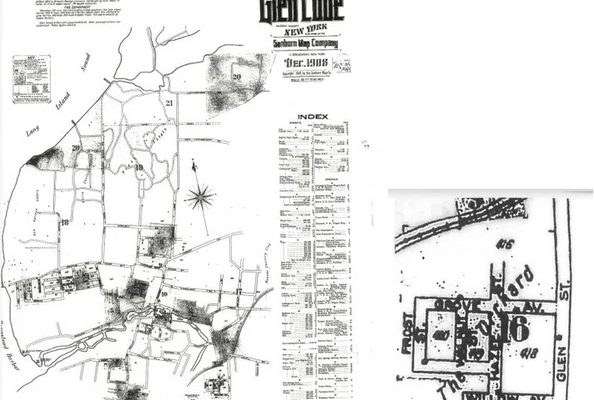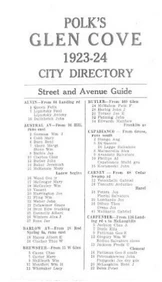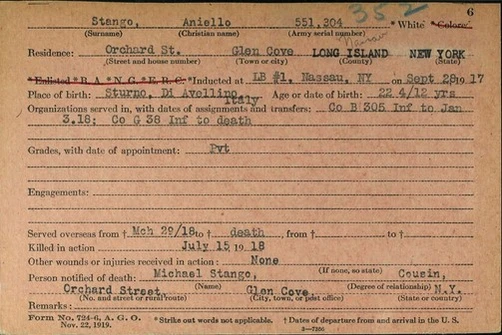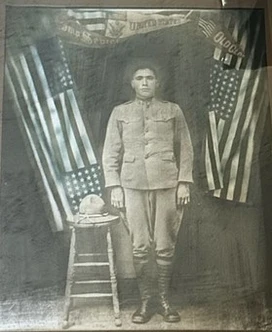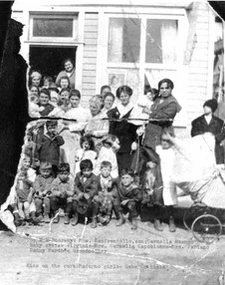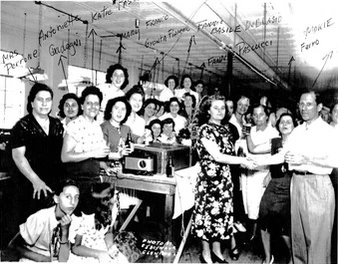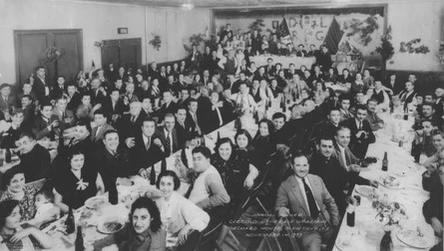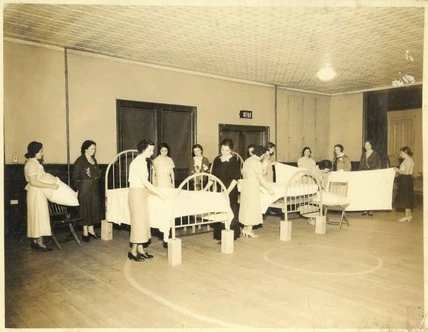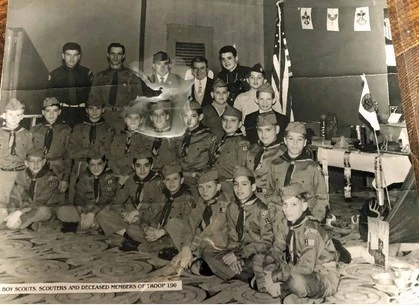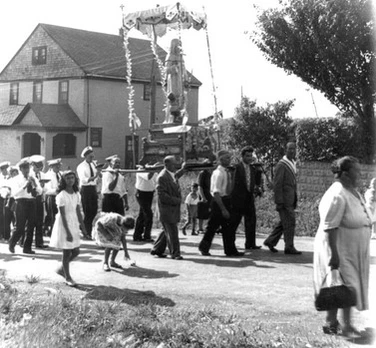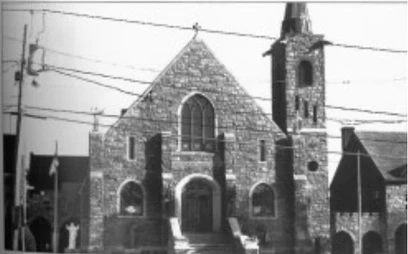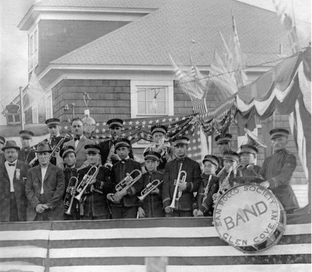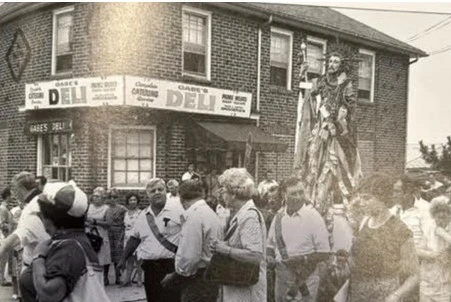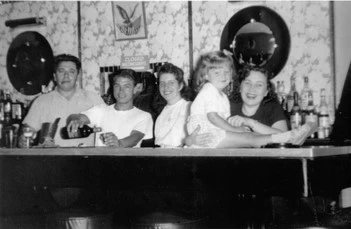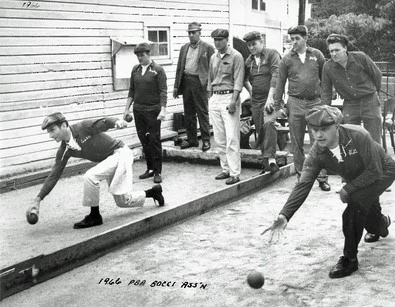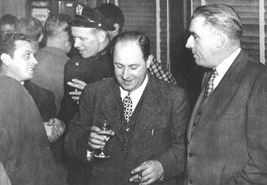The Orchard
F.W. Beers 1873
The Orchard was known as “Little Italy.” The 1873 F.W. Beers map, one of the earliest maps we have in the History Room, attributed ownership of this area to Mrs. J.A. Hall and Miss M. Craft. It occupies a triangular parcel of land in the Southern section of Glen Cove and is made up of only six streets: Stanco St., Capobianco St., Hazel St., Grove St., Willow St., and Carney St.. It is surrounded by Sea Cliff Avenue in the South, Cedar Swamp Road to the East, Route 107 (The Arterial Highway) to the West, and the LIRR tracks to the North. There were cornfields and dense woodlands; however, The Orchard was so named because of a multitude of apple orchards that were cultivated here. There were many Irish families farming in this area - the Kenarys and the McCarthys. There was a German family, the Allgaiers. At the turn of the century when Italian immigrants began to arrive in Glen Cove, this area was known to be farmed by a Mr. Carney, who Carney Street is named after. There was a Murphy family who trained trotting horses and seeing an influx of Italian laborers and an occasion for a new enterprise, built barracks on their farm to house the men.
1902 Sanborn Map
The earliest fire insurance maps for Glen Cove dated 1893 and 1902 do not show buildings in the area later known as The Orchard. In both these two maps, we see tracks leading to the Glen Street Station. The railroad was operated by the Glen Cove Branch RailRoad and opened on May 16,1867. For two years, it was the end of the line until expansion to Locust Valley started in 1869. For many years Glen Cove only had one station, the Glen Street Station.
Map of Italy Charles Scribner's Sons. Created New York, 1890
Library of Congress Geography and Map Division Washington, D.C. 20540-4650 dcu Many of the early Italian immigrants in Glen Cove came from the town of Sturno, an area east of Naples in the Province of Avellino in the Campania region, or the region of Calabria. Immigrants first settled in East New York and lived in crowded tenements. The construction and opening of the Brooklyn Bridge in 1883 was a monumental event, making travel between Manhattan and Long Island possible. http://hdl.loc.gov/loc.gmd/g6710.ct000373
1908 Sanborn Map
The December 1908 edition of the Sanborn Map expands to 21 pages. “The Orchard” is now on the map. Carney sold parcels of his land to the newcomers. The map shows modest single family units with two stories. On this map, we see a dance hall at 202/203 Hazel Street, a music hall at 303 Walnut, National (uncertain business) at 48/49 Grove Street , barber shops at the corner of Hazel and Grove Streets, and at 208 Hazel St, and a bakery at 316 Walnut Street. There is only one tenement (defined as a house that is divided into and rented out as separate residences) at the north end of Hazel Street 253/254. “Short Hazel” By 1910, Glen Cove’s population numbered approximately 10,000 Italians.
Polk's Glen Cove Directory
Directories are one of the most useful sources of information about cities and their residents. They provide personal and professional knowledge about a city’s inhabitants as well as information about its local business, civic, social, religious and charitable groups. The 1923-24 Polk's Glen Cove directory lists local orchard businesses: Pelusi Deli - corner of First Street and Cedar Swamp Road Dileggi and Pardo’s butcher shop - Grove Street Marfioti’s Fruit Store - Grove Street Maccarone’s Grocery Store - Grove Street Bianconi Grocery Store - Grove Street Ice Cream parlor run by Dileggi Sisters - Capobianco Street Sanfratello Bakery - Capobianco Street
Aniello Stanco - Military Record
After WWI, there were several street name changes; Maple becomes Stanco in honor of Aniello Stanco, and Willow becomes Capobianco honor of Luigi Capobianco - both US Army veterans killed in France in WWI. Aniello was 25 and Luigi was 30 when they died. Both were born in Italy.
Luigi Capobianco
Many immigrants volunteered to serve and proudly viewed their WWI service as a transformational event in their lives and an important part of their identities as new Americans. Stanco and Capobianco of The Orchard paid the ultimate sacrifice. Foreign-born soldiers made up over 18 percent of the U.S. Army during WWI. An estimated one in five draftees was born overseas. Some divisions such as the 77th Infantry from New York City were known for their immigrant ranks earning them the nickname, the “Melting Pot Division.”
Extended Families “Paesano”
Paesano is a person who shares one’s place of origin, a compatriot, especially among Italians or people of Italian descent. It is estimated that for every two Italian immigrants who came to America, one returned home. Jobs were easy to find but life was hard. Having paesano in place of blood relatives made a world of difference. There were many single men and boys, who needed a place to stay, to ease their loneliness, and to help. Family and friends wove a strong tapestry in the Orchard.
Hymie Frank
In later years, The Orchard had several shirt factories and workshops. The picture here depicts seamstresses at the Glen Cove Shirt Co. located at the corner of Willow and Hazel St. replacing an earlier music hall. Hymie Frank and his brothers were beloved in The Orchard. They paid $5 per week in wages and gave many young Italian women their first job. “Glen Cove’s Little Italy garment industry.”
The Orchard House c. 1917 Annual Dinner for the Community
The settlement movement was a reformist social movement that commenced in the 1880s and peaked in the 1920s in the United States. It aimed to bring the rich and the poor of society together in physical closeness and social interconnectedness. Mrs. Florence Gibb Pratt, wife of Herbert Lee Pratt (whose father was one of the founders of Standard Oil) along with other philanthropists established The Orchard House settlement to aid the needs of the new Italian immigrants in Glen Cove.
The Orchard House
The Orchard House contained a Library, a Hall for sports, pre-Kindergarten, and citizenship classes. On weekends, the Orchard House hosted “football weddings” which invited all family members including children. Guests were served beer, wine, and sandwiches. While not fancy, they were great celebrations. Additionally, the Orchard House put on plays and offered classes such as teaching women how to correctly make hospital beds.
Troop 190
The Orchard House hosted Boy Scout Troop 190 - Glen Cove Boy Scouts received their charter on June 15th, 1916. Scouting advocated for patriotism, courage, self-reliance, and American values, aligning with the values of the settlement movement. The leaders of Troop 190 had familiar surnames - Cocchiola (Gabe), Di Leo (Joseph), Suozzi (Joseph), Mercadante (Luke), and Stanco (Joseph). One man in particular, Dominick Genova served as the Scoutmaster of Troop 190 for over 30 years. Born in Glen Cove in 1910 and a lifelong resident, he and numerous other members who were also members of the Sons of Italy are credited with saving many “tough” boys from the neighborhood from veering down the wrong path.
St. Marino
St. Marino’s Feast was celebrated every May in honor of the Calabrese Saint. Hazel St. was festooned with decorations and a bandstand, where for three days, music, processions, and fireworks were featured. DeLuccas, who owned a bar on Hazel Street, would launch helium balloons bearing St. Marino’s image when the procession passed his business. This picture dated 1933 shows the statue of St. Marino was carried by devotees from Dominick Bellissimo’s house on First Street through the neighborhood before arriving at her permanent home in St. Rocco’s Church.
St. Rocco's Church
In 1935, St. Marino and St. Rocco Societies combined their funds to build La Cappella, a small wooden chapel. Ultimately, in 1937 after petitioning the Brooklyn Diocese for permission, St. Rocco’s broke ground in July for the construction of the Church of St. Rocco’s on 3rd St.
St. Rocco’s Society Band
The St. Rocco’s Society Band was a 40-member group that celebrated many Orchard events.
St. Theresa Sodality
The St. Theresa Sodality was a religious group within St. Rocco’s Church for young girls who devoted themselves to prayer and good deeds.
St. Rocco’s Feast
St. Rocco’s Feast was a high point of every July celebrated in honor of the Neapolitan saint. The food, entertainment, and games were legendary. Thomas Zuccala in his self-published book, The Way It Was, describes several competitions, “the most challenging contest was trying to climb a pole and reach the top of it to collect the grand prizes of hams, prosciutto, and cash. This was no easy task as the pole was greased and very slippery to climb. Many tried and failed. Some shimmied up carrying sacks of ashes which they put on the pole as they went up. The solution was to tie short pieces of rope around the pole as one rose and thus arrive at the top.”
Stango’s in The Orchards
In 1898, Frank Stango left Sturno, Italy by foot with three friends all aged 12 for the seaport at Naples. There, they boarded a transatlantic ocean liner for New York. They eventually made their way to Glen Cove. Frank was enterprising. In 1919, he bought a house at the corner of Grove and Hazel Streets. It had two storefronts on the ground floor and two apartments above. He rented one to Marianna who opened her namesake candy store. And in the other storefront, he opened a “restaurant.” It was not a restaurant as we envision it today with tables and chairs. It was more akin to a takeout restaurant - with a great pot of spaghetti and meats for single laborers and packed sandwiches that can be taken to work. Coincidently, Stango’s became a go-to place for the well-to-do in Glen Cove who frequented the establishment for its delicious Italian cuisine which was not available elsewhere. The Stango/Cocchiola family operated the restaurant continuously for nearly 94 years.
Orchard Sports
Orchard residents played a variety of sports from basketball to baseball to boxing; however none were more than bocce. Bocce courts could be found in many yards. Locals often harvested clay from Garvies Point to make the base.
Politics
As the Italians grew in population, politicians recognized the importance of courting their votes. Orchard residents were wooed by both the Republican and Democratic parties and their party affiliations were equal. During many Octobers, the Orchard House hosted political rallies with loudspeakers sending appeals to voters. The Republicans were known to serve hot dogs, beer, and soda after their long rallies. Democrats, the poorer of the two parties, only served beer to adults. This is a photo of Mayor Luke Mercandante celebrating his victory as the first Italian mayor of Glen Cove. While in the Army, Captain Luke Mercadante, served as a lawyer in the famous Nuremberg Trial of Nazi war criminals. Mayor Mercadante was the breakthrough Democratic candidate in 1947. He went on to serve two terms as Mayor. Joe Stanco, the namesake of Stanco Park followed with two terms as a Republican Mayor.

